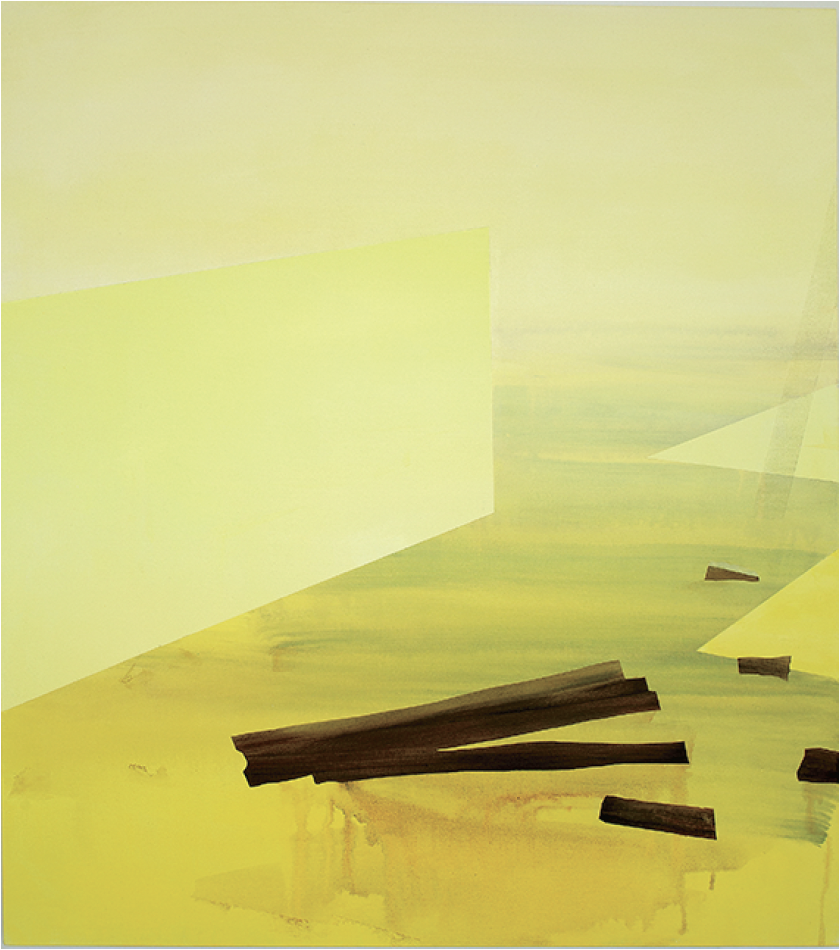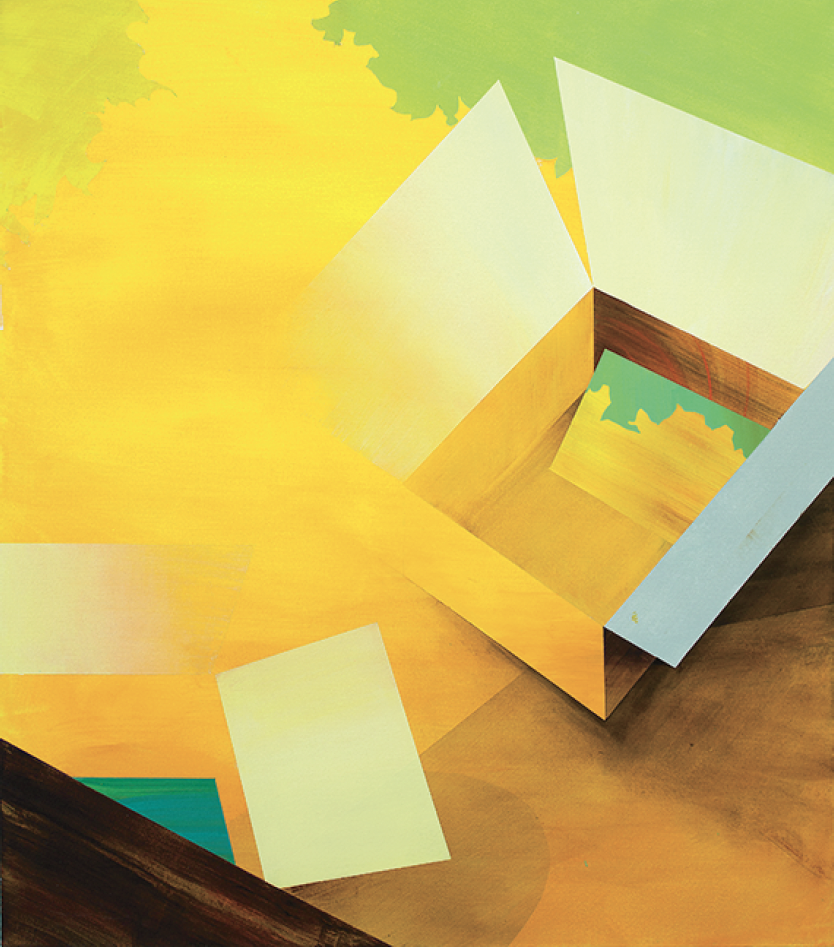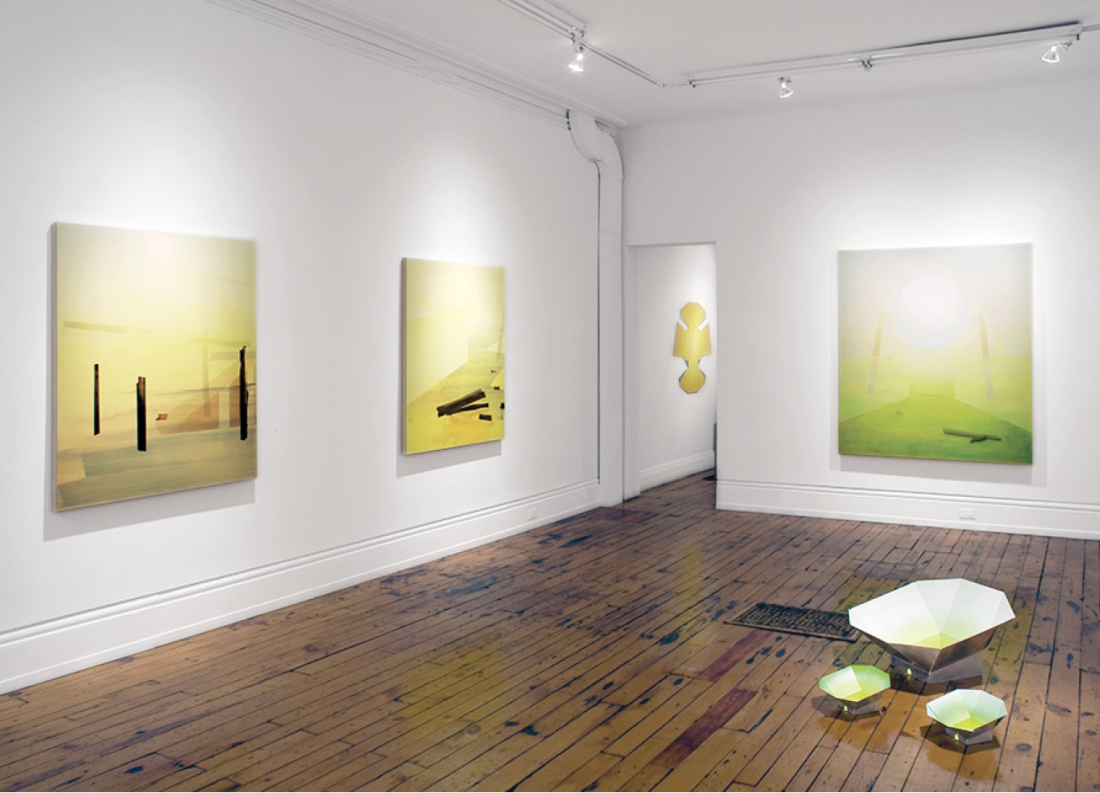Leigh Bridges
Some 12 years into her career, I’m going to suggest that Winnipeg-based artist Leigh Bridges’s reputation remains obscure relative to the bravura work that she consistently produces. Obscurity is actually an incongruent term to apply to Bridges—her paintings are sundappled and dazzled to the max, yet contemplative too, and accordingly restrained. They typically depict a natural, outdoor vignette that feels near and familiar, as if the artist has just stepped back from the place where she’d laid down her bedroll moments ago. Bridges captures the infinitude of proximity, the intimate sublime. Her palette admits not only surface colour, but its sensation through airborne thermal and spectral buzz.
The prevalence of linear Western models of light, vision and, indeed, experience in art cannot be overestimated. They encompass not only the theoretical scope of Alberti’s De Pictura treatise of Renaissance perspective, but also baroque depictions of Christ’s stigmata emanating from (and reciprocating back toward) a single divine source. Optical sciences relied on mirror and lens instruments that redirected and focused true unwavering rays of light; so too did realism. The temporal dispersions of scenic life amid lapping water, milling crowds, etc. by the Impressionist painters presupposeed scattering punctuations on the steady, observing eye of the onlooker. As do, somehow, the Op images of Bridget Riley upon their viewer.

Leigh Bridges, Light Collector (Yellow Orange Light), 2016, acrylic on canvas, 42 x 48 inches. All images courtesy the artist and Paul Petro Contemporary Art, Toronto.
Bridges negotiates something of a collector vision that becomes especially pronounced in her latest show. She portrays the world irradiated in waves of cosmic and terrestrial energies in whose gamut appearances are modulated. She adopts the role of painter-prospector, seeking pools of uncorrupted vibrancy in which to immerse and plenish herself. Whereas prior bodies of work emphasized the quest, with evidence of the outposts set up along the way, “Atmospheric Resonance” enters the sought-after energy sources and taps their powers with various apparatus and techniques. These combine elements and purposes both practical and mystical, devices to exit and enter the grid, so to speak, whether of modern society or modern painting.
The exhibition consists of half-a-dozen canvases, the same number of “cookstoves” and three related photographs of balsa and basswood studies. The latter are scale models of solar cookstove frames: one made “as per Internet instructions,” the other two “revised,” presumably modified by Bridges herself. Shot on what appears to be a table or desktop, they anchor Bridges’s investigation as hypothetical, imagined from the confines of her studio. The cookstoves, which she produces herself, harness the hovering energies of modern art, converting metallic reflectivity into conviction in pure luminosity. Each is titled Colourfield Cookstove, with further parenthetical distinctions alluding to season and time of day, i.e., Early Spring, 6 am or Summer, 2 pm. That is, each one is an image of its moment. Bridges pursues correlation between the vibrational fields of the earth and her corporeal circadean rhythms. Compared to the somewhat elaborate models described above, the colourfield cookstove design is rudimentary and eminently portable. It could be part of an emergency kit tucked under the car seat. Each starts as a flat, laser-cut sheet of aluminum, notched and perforated to fold into an articulated, shallow receptacle of ambient energy. Their upward surfaces are almost entirely painted in gradated hues associated with bright light— whites, yellows and light oranges. Only the flanges that will tuck behind the painted sections are left unpainted. The back/undersides likewise remain raw aluminum. Three are hung (simply, by a single nail from the wall, like pots or pans), drawing attention to their elegant, planar symmetry (Bridges calls them Flatpacks), functional elaborations of the central square and the diffusion of the radiant/ convergent colourfield. The other three have been folded and sit directly on the wood floor of the gallery, an echo of the tabletop that displays the balsa models. One of these models, Albers, Mid- Spring, 9 am, has at its core a wittily appropriate homage to Homage to the Square.

Leigh Bridges, Reflective Boxes, 2016, acrylic on canvas, 42 x 48 inches.
The Colourfield Cookstoves so deftly and compactly activate the gallery as to make the paintings comparatively challenging to construe. Each one takes you out of the space’s immediate experience and into a haze that is only partially defined by pictorial conventions. Here, light reveals and conceals. Reflective Boxes corresponds most closely to Bridges’s cookstoves. However these are more basic still, apparently open cartons. Although Bridges has always been partial to the hard edge, which invariably bucks up the persuasiveness of her perspectival illusions, here and there they vanish, leaving no delineation between figure and ground, however no less semblant of form for that loss. At the bottom left corner, a disruptive plane of grained brown cuts across the picture, suggesting that this spatial invention remains in the studio.
Latitude Adjuster, Solar Panels, Solar Effects, Light Collector (Yellow Light) and Structures (Yellow Light) are more ambiguous yet. Their revelations of form seem to disqualify light even as their spaces are suffused by it. Apparatus are faintly discernible, powdered by interaction with whatever miasmic fields of energy enshroud the place. By contrast, various sticks, some lying about, others knocked upright into provisional posts, appear dark and dense, as if impervious to the transfer process, nearly inert in their own slow entropy. Throughout, Bridges demonstrates that she is a superlatively efficient and effective painter, capable of hitting her marks without error or inadvertant discrepancy. This is particularly evident in the transparent (and unforgiving) washes and glazes she deploys. The earlier mentioned canvases are each 48 x 42 inches. The capstone of the exhibition is the largest (62 x 55 inches) and lends it its title, Atmospheric Resonance Sensor. Its configuration owes much to the complicated scale models. Alone of all the works, it describes a system of lenses and mirrors that concentrate pale blue sky into an intense white light. The structure totemically commands the picture space and, by extension, the gallery, a more abstract variation of Georgia O’Keeffe’s magisterial Summer Days, 1936. In its thrall, it is impossible not to connect the words “resonance” and “romance.” ❚

Installation view, “Atmospheric Resonance,” 2016, Paul Petro Contemporary Art, Toronto. Photo: Cheryl O’Brien.
“Atmospheric Resonance” was exhibited at Paul Petro Contemporary Art, Toronto, from September 9 to October 8, 2016.
Ben Portis is a curator living in Toronto.

